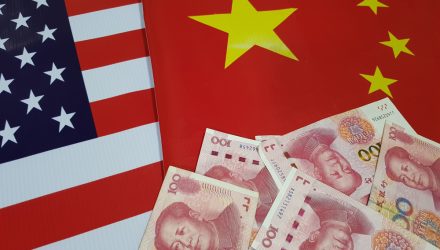Investors should consider the growth opportunity in China and look to targeted exchange traded fund strategies best positioned to capture expanding areas of the Chinese markets.
In the recent webcast, Why Advisors Should Take a Closer Look at China A-Shares, Brendan Ahern, Chief Investment Officer, KraneShares, highlighted the long-term benefits of investing in the emerging markets, notably in Chinese equities, as the developing economy continues to outpace growth in developed countries.
Ahern noted that the recent volatility has already been baked into the Chinese markets. For example, trade tension with China has decreased significantly since its high in September 2018 and is currently at 10% within the index the Goldman Sachs US-China Relationship Barometer Index.
China is still the place to be in the global market as U.S. multinationals continue to look to China for growth. Specifically, U.S. multinationals’ sales in China have amounted to $356 billion in revenue so far in 2022, Ahern added.
Looking at the ongoing disruption caused by Russia’s invasion of Ukraine, Ahern pointed out that China imports both Ukrainian wheat and Russian natural resources and does not benefit from higher commodity prices but has seen a limited impact on its CPI. The trade disruption with Russia is also less impactful on the Chinese economy compared to the U.S.
China has also taken steps to improve regulatory oversight to meet technological advances. Specifically, China’s regulatory framework has covered four major categories, including education, anti-trust in the tech space, financial technology, and data security. While the initial shakeup from heightened regulations has weighed on China’s market, officials have signaled they are easing up on their heavy-handed approach.
Looking ahead, Ahern pointed out that growth, a dovish monetary policy shift, and relaxation of its zero-Covid policy will be prevailing themes for the rest of 2022. For example, taking from the National People’s Congress, China is targeting 2022 GDP Growth of 5.5% while keeping inflation near 3%. They aim to create 11 million new urban jobs and lower the unemployment rate to 5.5%. Beijing will continue pro-growth monetary policy from 2021, consistent with recent PBOC communications in January.
“We expect policy rates to stay low, fiscal policy to turn more expansionary, especially towards new infrastructure, and targeted liquidity relaxation to small and medium-sized enterprises (SMEs),” Ahern said.
After the bout of strict lockdown measures, China could also relax its zero-Covid policy. New Covid policies were released on June 5th. These policies are meant to prevent local governments from instituting the strict lockdown measures seen lately. Ahern argued that this could soften the economic impact of any future disease prevention measures, and consumer confidence may improve.
As investors look for ways to access China’s market, Ahern highlighted the STAR Market, which primarily supports high-tech infrastructure and strategic emerging industries, including artificial intelligence, the internet, big data, cloud computing, and high-tech manufacturing. Companies listed on the STAR Market help advance China’s national strategy development goals.
“The STAR Market’s unique listing rules and notable success since launching have quickly made the exchange an attractive option for China’s leading science and technology unicorns,” Ahern said.
To access China’s market, investors can turn to something like the KraneShares Bosera MSCI China A Share ETF (KBA), which provides exposure to the MSCI China A 50 Connect Index. This ETF seeks to capture 50 large-cap companies with the most liquidity listed on the Stock Connect while offering risk management through the futures contracts for eligible A-shares listed on the Stock Connect. The index utilizes a balanced sector weight methodology to expose the breadth of the Chinese economy.
The KraneShares SSE STAR Market 50 index ETF (KSTR) offers exposure to the STAR Market, which is designed to function similarly to the Nasdaq in U.S. markets, with less stringent requirements for companies to be listed on it, allowing up-and-coming technology companies to gain access to markets and obtain vital investments to fuel their growth. KSTR tries to reflect the performance of the Shanghai Stock Exchange (SSE) Science and Technology Innovation Board 50 Index, a benchmark of the 50 largest companies listed on the STAR Market. To be eligible for inclusion in the index, stocks must meet certain market capitalization and liquidity screens and have been trading for at least 11 days.
China’s rapid economic development has impacted the environment. Air and water pollution levels in China are much higher than those recommended by the World Health Organization. China has also outpaced other world leaders in expanding electric power capacity from renewable technologies. In 2022, China plans to add a record 140 gigawatts of capacity from the clean energy sources or more than the rest of the world combined in 2020.
Consequently, China has begun to take a greater interest in sustainable programs to limit the negative effects of pollution on the economy. The KraneShares MSCI China Clean Technology Index ETF (KGRN) capitalizes on investing in clean technology in China’s growing economy. KGRN tracks the MSCI China IMI Environment 10/40 Index and is based on five clean technology themes: alternative energy, energy efficiency, green building, sustainable water, and pollution prevention.
Financial advisors interested in learning more about China A-shares can watch the webcast here on demand.

